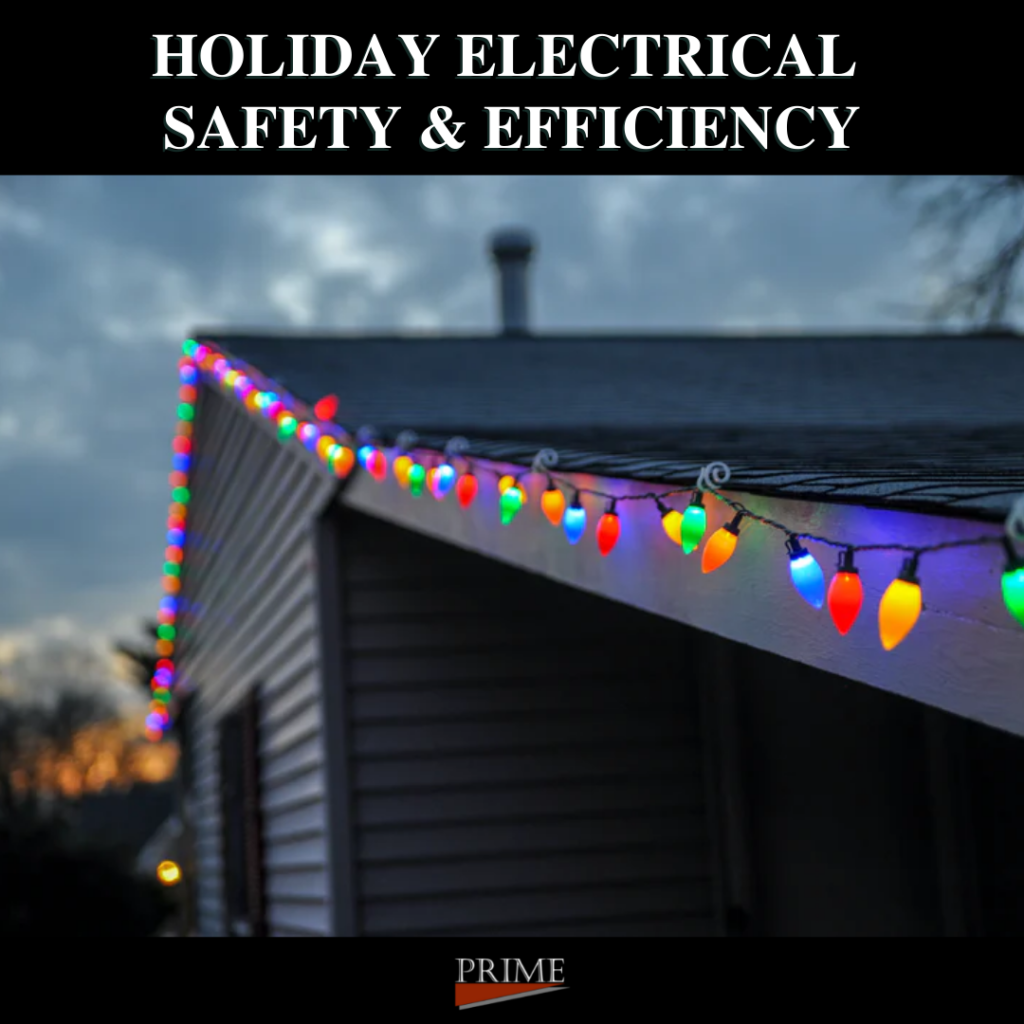
As the holidays come around and people start decorating and putting up Christmas lights, it is important to remember that certain aspects need to be addressed. These two issues are the safety of holiday electrical designs and the efficiency behind the holiday electrical systems - that is why in today's article we will be discussing Holiday Electrical Safety and Efficiency. Read below for a guide to a safe holiday and be sure to read the side columns for tips and tricks on how to have more a more energy-efficient holiday - helping save the planet and your wallet!
At Prime Electrical Services, we always put safety first! Therefore, safety should be your most prominent concern when decorating for the holidays. Failure to address safety concerns could result in electrocution or start a fire - potentially harming property or worse, you and your family. Be sure to protect your family by taking the time to do a safety check and ensure that all your electrical systems are up to code. Not sure how to get started? Don't worry! We have some safety checklist tips to help you get there! Let's get started!
1. Check for an inspection tag or certification label
Your electrical decorations (such as lights, certain lawn decorations, and more) should have an inspection tag on their power cord. Cords that fail to bear a label have not been tested for safety and could be hazardous.
2. Inspect electrical decorations for damage prior to use
Just like any other electrical work, all cords and equipment for holiday decorations must be inspected before use. Cracked or damaged sockets, loose or bare wires, missing or broken bulbs, and loose connections have the potential to shock someone or start a fire.
3. Only use the proper lights - place only outdoor lights outdoors
If you are installing lights or electrical decorations outdoors, they must be specifically designed for the outside in order to safely handle weather conditions. Placing indoor lights or decorations outside could result in a fire!
4. Be sure to baby and pet proof!
Our small children and pets are most susceptible to shock or injury when it comes to electrical safety and we need to protect them the most! Always keep cords away from children and animals to make sure that they cannot chew, tear, or pull any electrical equipment. Make sure that children and pets are supervised. If they tamper with the lights or equipment, the damage they create could start a fire later or even worse, harm or electrocute them.
5. Protect cords from damage
To properly prevent hazards, electrical cords should never be pinched by furniture, crammed through doors or windows, squished under rugs, or located near heat sources. They should also be watertight and not exposed to places where they will come in contact with anything liquid.
6. Use proper fasteners and ditch the staples or nails
It is not safe to fasten cords with staples, nails, tacks, or screws. Instead, fasten your lights with insulated hooks to avoid any electrical mishaps.
7. Don't provide kindling
Furniture, curtains, wrapping paper, tissue paper, the Christmas tree itself, and an array of other objects can catch fire easily and burn quickly. Many holiday fires are caused when certain objects are left too close to a heat or electrical source. Keep your electrical equipment away from these items! Keep your Christmas tree fresh and watered at all times. A dry Christmas tree is basically kindling. Don't feed the fire! On the same note, an indoor heater or fireplace can make things feel cozy. Be sure to keep flammable items a minimum of 3 feet away at all times to prevent fire! You should also check the propane in your fireplace (if you have it) prior to starting it up. Leaked propane or build up could result in a blast!
8. Do not overload electrical outlets
An Overloaded electrical outlet can easily cause a fire. Avoid overloading outlets and plug only one high-wattage into each outlet at a time. It is also a good idea to use extension cords or power strips with circuit breakers installed as another level of safety.
9. Don't connect too many light strands
The U.S. Fire Administration recommends connecting no more than three strands of lights. However, if you’re LEDs (which you probably should be), the U.S. Department of Energy says it’s safe to connect 25 strands end to end.
10. Cooking Devices
It does not have to be a decoration to be a potential electrical hazard. A large portion of home fires result from cooking accidents. Never leave your cooking food or active electrical cooking supplies unattended!
11. Bedtime or leaving the house
Whether you're turning in for the night or heading out, be sure that all of your electrical decorations and equipment are off and unplugged.
12. Do not alter your electrical devices.
Do not alter your devices. For example, removing the third prong (the grounding pin) removes the safety mechanism working to prevent shock in case of electrical failure.
13. Holidays over? Clean your electrical equipment correctly and invest in proper storage
Always follow manufacturer guidelines when cleaning any device. The damage done to lights or electrical decorations over the year-long storage period can cause electrical equipment to malfunction the following year. Don't take that risk. Pack your decorations away in well-sealed bins or containers to prevent water damage and rodents from chewing cords. You can check out proper storage bins on Amazon, like this one here.
We hope that you found our Holiday Electrical Safety and Efficiency tips helpful! Hopefully, they will keep you and your family safe, warm, and festive this holiday season! Until next time!
Energy Conservation Tip # 1: LEDs
This tip doubles as both a holiday electrical safety and efficiency tip. We encourage you to switch to LED lights and decorations for a variety of reasons. First, in the long run you will save money and operate more efficiently. According to energy.gov, LED lights can cut your electricity bill drastically during the holiday season. Their study showed that LED lights drastically reduced the cost of running lights 12 hours per day for 40 days. Standard C-7 lights with 125 bulbs cost $25.13 to run. LED lights with 280 bulbs, on the other hand, cost only $0.56 to run. On top of this, LED light strings also last longer and are safer to use than traditional incandescent light strings - making them a better investment and safer alternative. Lastly, LED lights are also better for the planet. It is a win-win situation!
Energy Conservation Tip # 2: Fiber Optic Decorations
Fiber optic decorations and Christmas trees are great in the energy efficiency department. They often only rely on a single bulb to light up a decoration!
Energy Conservation Tip # 3: Decoration Timer
Make your life a little easier, your electricity bill a little cheaper, and your footprint a little smaller by investing in a light and decoration timer. You can find affordable indoor/outdoor timers like this one on Amazon.
Energy Conservation Tip # 4: When Guests Come in, Crank Down the Heat
As family and friends roll in for Christmas and other holidays, you will likely be entertaining and cooking a lot. The combination of heat from the kitchen and extra bodies in the house are sure to make your home steamy! When they arrive, turn down the thermostat to cut costs and save energy.
Energy Conservation Tip # 5: Cook Efficiently
Cooking can take up a lot of energy! Put multiple dishes in the oven at a time to save energy and keep the lids on pots and pans to trap heat and make food cook faster!
Holiday Recipe: PRIME Rib
You're just in time for another fun holiday recipe from Prime! We thought that a PRIME rib would be appropriate - pun intended. Let's get started!
INGREDIENTS
- 1 (6 pound) boneless prime rib roast
- 2 tablespoons prepared horseradish
- 2 tablespoons Dijon mustard
- 2 teaspoons kosher salt
- 2 teaspoons coarsely ground black pepper
- 2 teaspoons dried thyme
- 2 teaspoons garlic powder
- 2 stalks celery, cut into 2-inch pieces
- 1 carrot, cut into 2-inch pieces
- 1 small unpeeled onion, quartered and separated
- 2 teaspoons concentrated beef base (paste)
- 1 ½ cups water
- 1 teaspoon cornstarch
- 1 teaspoon water
DIRECTIONS
STEP 1) The day before serving, remove the roast from the package, and dry thoroughly with paper towels. Set the roast on a baking sheet, and place in refrigerator overnight. Remove from refrigerator 1 hour before cooking time to allow meat to reach room temperature. Rub the roast all over with horseradish and Dijon mustard. In a bowl, mix together the kosher salt, black pepper, thyme, and garlic powder; sprinkle the spice mix over the roast. STEP 2) Preheat oven to 450 degrees F (230 degrees C). Place the celery, carrot, and onion pieces into the bottom of a roasting pan. Place the roast on top of the vegetables. Roast in the preheated oven for 30 minutes. Reduce oven temperature to 350 degrees F (175 degrees C), and roast until the meat is browned and an instant-read meat thermometer inserted into the thickest part of the roast reads 130 to 135 degrees F (54 to 57 degrees C) for medium-rare. STEP 3) Remove from oven, transfer roast to a platter, and cover with a tent of aluminum foil. Allow to rest for 30 minutes. Temperature of the meat will rise about 10 degrees during resting time. STEP 4) To make au jus sauce, skim excess fat from the pan drippings in the roasting pan. Place the pan over a burner set to medium heat, and stir in the beef base and 1 1/2 cup of water. Bring to a boil, scraping and dissolving any brown flavor bits from the bottom of the pan. Strain out and discard the vegetables. Combine the cornstarch and 1 teaspoon of water in a small bowl, and whisk the mixture into the sauce. Allow the sauce to thicken slightly (sauce will be thin), pour into a gravy boat, and serve with roast.
To find the full recipe, click here to visit allrecipes.








